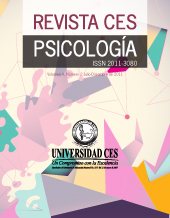Validation of a Standardized Procedure for Measuring Implicit Attitudes to Suicide
DOI:
https://doi.org/10.21615/cesp.10.2.5Keywords:
Evaluation Procedure, Implicit Attitudes, IRAP, Suicide, University StudentsAbstract
The purpose of the present study was to validate a standardized procedure for measuring attitudes towards suicide in university students. As the concurrent validation criteria for the Implicit Relational Assessment Procedure (IRAP) to suicide (IRAP-HS), the Positive and Negative Suicidal Ideas Inventory (PANSI) and the Beck Hopelessness Scale were administered to a sample of 102 students of the University of Nariño. Although the results found lack of a strong response to consider the clinical applicability of the IRAP-HS in the short term, the behavior of the DIRAP scores (obtained through a process that seeks to counteract the effects of participant variability related to factors such as age, motor skills and intelligence) in the different comparison groups does not definitively allow dismissing that the response latency to the trials is being affected by the degree of consistency between the verbal network of the participants and the relationships specified in the contingency arrangements of the procedure. Finally, some implications of the results for the applicability of IRAP-HS in clinical practice are analyzed.
Downloads
References
Alcaldía de Pasto. (2015). Lesiones de causa externa no fatal municipio de Pasto. Comparativo enero- junio años 2014-2015. Observatorio del Delito. Recuperado de: http://www.pasto.gov.co/index.php/nuestras-dependencias/secretaria-de-gobierno/observatorio-del-delito
Alcaldía de Pasto. (2017). Líneas de vigilancia observatorio de delito comparativo 2015 -2016. Recuperado de: http://www.pasto.gov.co/index.php/nuestras-dependencias/secretaria-de-gobierno/observatorio-del-delito
Barnes-Holmes, D., Barnes-Holmes, Y., Power, P., Hayden, E., Milne, R., & Stewart, I. (2006). Do you really know what you believe? Developing the Implicit Relational Assessment Procedure (IRAP) as a direct measure of implicit beliefs. The Irish Psychologist, 32(7), 169-177.
Barnes-Holmes, D., Barnes-Holmes, Y., Stewart I., & Boles, S. (2010). Oregon Research Institute 2010, A Sketch of the Implicit Relational Assessment Procedure (IRAP) and the Relational Elaboration and Coherence (REC) Model. The Psychological Record, 60(3), 527–542.
Barnes-Holmes, D., Eilish, H., & Barnes-Holmes, Y. (2008). The Implicit Relational Assessment Procedure (IRAP) as a Response- Time and Event-Related- Potentials Methodology for Testing Natural Verbal Relations: A Preliminary Study. The Psychological Record, 58, 497–516.
Barnes-Holmes, D., Hayden, E., Barnes-Holmes, Y., & Stewart, I. (2008). The Implicit Relational Assessment Procedure (IRAP) as a response-time and event-related-potentials methodology for testing natural verbal relations: A preliminary study. The Psychological Record, 58(4), 497.
Barnes-Holmes, D., Murphy, A., Barnes -Holmes, Y., & Stewart, I. (2010). The Implicit Relational Assessment Procedure (IRAP): Exploring the impact of private versus public contexts and the response latency criterion on pro-white and anti-black stereotyping among white Irish individuals. The Psychological Record, 60, 57–80.
Barnes-Holmes, D., Waldron, D., Barnes-Holmes, Y., & Stewart, I. (2009). Testing the validity of the Implicit Relational Assessment Procedure and the Implicit Association Test: Measuring attitudes toward Dublin and country life in Ireland. The Psychological Record, 59(3), 389–406.
Beck, A., Weissman, A., Lester, D., & Trexler, L. (1974). Measurement of pessimism, the Beck Hopelessness Scale. Journal of Consulting and Clinical Psychology, 42, 861-865.
Briñol, P., Horcajo, J., De la Corte, L., Valle, C., Gallardo, I., & Díaz, D. (2004). El efecto de la ambivalencia evaluativa sobre el cambio de actitudes. Psicothema, 16(3), 373-377.
Carpenter, KM., Martinez, D., Vadhan, NP., Barnes-Holmes, D., & Nunes, EV. (2012). Measures of attentional bias and relational responding are associated with behavioral treatment outcome for cocaine dependence. The American Journal of Drug and Alcohol Abuse, 38 (2), 146-54.
Cifuentes, C. (2009). Propiedades psicométricas de la Escala de Desesperanza de Beck en una muestra bogotana. Psychologia: avances de la disciplina, 3(2), 17-30.
Córdova, M., & Rosales, J. (2011). Consistencia interna y estructura factorial de la Escala de Desesperanza de Beck en estudiantes mexicanos. Revista de Psicología, 29(2), 289-309.
Cullen, C., & Barnes-Holmes, D. (2008). Implicit pride and prejudice: A heterosexual phenomenon. Modern prejudice, 195-223.
Cullen, C., Barnes-Holmes, D., Barnes-Holmes, Y., & Stewart, I. (2009). The Implicit Relational Assessment Procedure (IRAP) and the malleability of ageist attitudes. The Psychological Record, 59, 591–620.
Chan, G., Barnes- Holmes, D., Barnes- Holmes, Y., & Stewart, I. (2009). Implicit attitudes to work and leisure among North American and Irish individuals: A preliminary study. International Journal of Psychology and Psychological Therapy, 9(3), 317-334.
Dawson, D., Barnes-Holmes, D., Gresswell, M., Hart, A., & Gore, N. (2009). Assessing the implicit beliefs of sexual offenders using the Implicit Relational Assessment Procedure: A First Study. Sexual abuse. A Journal of research and treatment, 21(1), 57-75.
De Houwer, J. (2002). The implicit association test as a tool for studying dysfunctional associations in psychopathology: Strengths and limitations. Journal of Behavior Therapy & Experimental Psychiatry, 33, 115-133.
De las Cuevas, C., & González de Rivera, J. (1992). Autoinformes y respuestas sesgadas. In Anales de psiquiatría, 8(9), 362-366.
Echeburúa, E., Muñoz, J., & Loinaz I. (2011). La evaluación psicológica forense frente a la evaluación clínica: propuestas y retos de futuro. International Journal of Clinical and Health Psychology, 11(1), 141-159.
García de Jalón, E., & Peralta, V. (2002). Suicidio y riesgo de suicidio. Anales del sistema sanitario de navarra, 27(3), 87-96. Disponible en: http://recyt.fecyt.es/index.php/ASSN/article/view/5570/4581
García-Alandete, J., Gallego-Pérez, J. F., & Pérez-Delgado, E. (2008). Sentido de la vida y desesperanza: un estudio empírico. Universitas Psychologica, 8(2), 447-454.
Greenwald, AG., Nosek, BA., & Banaji, MR. (2003). Understanding and using the Implicit Association Test: I. An improved scoring algorithm. Journal of Personality and Social Psychology, 85, 197-216.
Hayes, S. C., Barnes-Holmes, D., & Roche, B. (2001). Relational frame theory: A post-Skinnerian account of human language and cognition. New York: Kluwer Academic/Plenum press.
Hughes, S., & Barnes-Holmes, D. (2011). On the formation and persistence of implicit attitudes: New evidence from the Implicit Relational Assessment Procedure (IRAP). The Psychological Record, 61, 391–410.
Hughes, S., Barnes-Holmes, D., & Vahey, N. (2012). Holding on to our functional roots when exploring new intellectual islands: A voyage through implicit cognition research. Journal of Contextual Behavioral Science, 1(1), 17-38.
Instituto Departamental de Salud de Nariño. (2013). Boletín Epidemiológico 2013. Recuperado de: http://www.idsn.gov.co/
Instituto Nacional de Medicina Legal y Ciencias Forenses. (2015). Forensis, datos para la vida. Recuperado de: http://www.medicinalegal.gov.co/documents/88730/1656998/Forensis+Interactivo+2014.24-JULpdf.pdf/9085ad79-d2a9-4c0d-a17b-f845ab96534b
Instituto Nacional de Medicina Legal y Ciencias Forenses. (2013). Informe de tasas de suicidio. Recuperado de: http://www.medicinalegal.gov.co/
Jané-Llopis, E. (2004). La eficacia de la promoción de la salud mental y la prevención de los trastornos mentales. Revista de la Asociación Española de Neuropsiquiatría, 89, 66-77.
Ley 1090 de 2006. Código Deontológico y Bioético del psicólogo. Recuperado de: http://tribunales.colpsic.org.co/tribunales_archivos/LEY_1090_DE_2006_actualizada_marzo_2012.pdf
Malik, L. (2010). Ullin Place's Cartesian Remnants: Identity Theory and the Lack of Animal Minds. Recuperado de: https://core.ac.uk/download/pdf/38184887.pdf
McKenna, I., Barnes, D., Barnes Y., & Stewart, I. (2007). Testing the fake-ability of the Implicit Relational Assessment Procedure (IRAP): The first study. International Journal of Psychology and Psychological Therapy, 7(2), 253-268.
Mikulic, I., Cassullo, G., Crespi, M., & Marconi, A. (2009).E scala de desesperanza BHS (A. Beck, 1974): Estudio de las propiedades psicométricas y baremización de la adaptación argentina. Facultad de Psicología - UBA / Secretaría de investigaciones / Anuario de investigaciones, 16, 365-373.
Montero, I., & León, O. (2007). A guide for naming research studies in Psychology. International Journal of clinical and Health psychology, 7 (3), 847-862.
Murphy, C., MacCarthaigh, S., & Barnes-Holmes, D. (2014). Implicit Relational Assessment Procedure and Attractiveness Bias: Directionality of Bias and Influence of Gender of Participants. International Journal of Psychology and Psychological Therapy, 14(3), 333-351.
Nicholson, E., & Barnes-Holmes, D. (2012). The Implicit Relational Assessment Procedure (IRAP) as a measure of spider fear. Psychological Record, 62(2), 263-277.
Nisbett, R., & Wilson, T. (1977). Telling more than we can know: Verbal reports on mental processes. Psychological Review, 84, 231-259.
Organización Mundial de la Salud [OMS]. (2014). Prevención del suicidio. Recuperado de: http://www.who.int/mental_health/suicide-prevention/world_report_2014/es/
Osman, A., Gutiérrez, P., Kopper, B., Barrios, F., & Chiros, C. (1998). The positive and negative suicide ideation inventory: Development and validation. Psychological reports, 82, 783-793.
Place, U. (1999). Token-versus type-identity physicalism. Anthropology and Philosophy, 3, 21-31.
Power, P., Barnes-Holmes, D., Barnes-Holmes, Y., & Stewart, I. (2009). The Implicit Relational Assessment Procedure (IRAP) as a measure of implicit relative preferences: A first study. The Psychological Record, 59(4), 621–640.
Ribes, E. (1990). Psicología general. México: Trillas.
Ribes, E., Ontiveros S., Torres C., Calderón G., Carvajal J., Martínez C., & Cargas I. (2005). La igualación de la muestra como selección de los estímulos de segundo orden: Efectos de dos procedimientos. Revista Mexicana de análisis de la Conducta, 31(1), 1–22.
Roca, J. (2006). Automotivación. México: Editorial Paidotribo.
Roddy, S., Stewart, I., & Barnes-Holmes, D. (2010). Anti-fat, pro-slim, or both? Using two reaction-time based measures to assess implicit attitudes to the slim and overweight. Journal of Health Psychology, 15(3), 416-425
Salgado, J. (2005). Personalidad y deseabilidad social en contextos organizacionales: implicaciones para la práctica de la psicología del trabajo y las organizaciones. Papeles del psicólogo, 26(3), 115-128.
Vahey, N., Barnes-Holmes, D., Barnes-Holmes, Y., & Stewart I. (2009). A first test of the Implicit Relational Assessment Procedure (IRAP) as a measure of self-esteem: Irish prisoner groups and university students. The Psychological Record, 59, 371–388.
Vahey, N., Boles, S. & Barnes-Holmes, D. (2010). Measuring adolescents’ smoking-related social identity preferences with the Implicit Relational Assessment Procedure (IRAP) for the first time: A starting point that explains later IRAP evolutions. International Journal of Psychology and Psychological Therapy. 10(3), 453-474.
Villalobos, F. (2007). Aplicación del modelo procesual de estrés a la conducta suicida. Revista Universidad y Salud, 8, 126 – 141.
Villalobos, F. (2009). Validez y fiabilidad del Inventario de Ideación Suicida Positiva y Negativa – PANSI, en estudiantes colombianos, Revista Universitas Psychologica, 9 (2), 509-520.
Villalobos, F., Arévalo, C., & Rojas, F. (2012). Adaptación del Inventario de Resiliencia ante el Suicidio (SRI-25) en adolescentes y jóvenes de Colombia. Revista Panamericana Salud Publica, 31(3), 233.
Downloads
Published
How to Cite
Issue
Section
License
Copyright (c) 2017 Edwin Gerardo Luna Tascón, Christian Alexander Zambrano Guerrero, Ana Karen Ceballos Mora, Fredy Hernan Villalobos Galvis

This work is licensed under a Creative Commons Attribution-NonCommercial-ShareAlike 4.0 International License.
Each manuscript is accompanied by a statement specifyingThat the materials are unpublished, that have not been previously published in printed formatElectronic and that they will not be presented to any other means before knowing the decision of the magazine. ThroughoutIn case, any previous publication, sea in printed or electronic form, must be made known to the editorial staffWriting The authors attach a signed statement stating that, and the manuscript is acceptedFor publication, the rights of reproduction are the exclusive property of the Journal CES Psychology.| Article metrics | |
|---|---|
| Abstract views | |
| Galley vies | |
| PDF Views | |
| HTML views | |
| Other views | |




